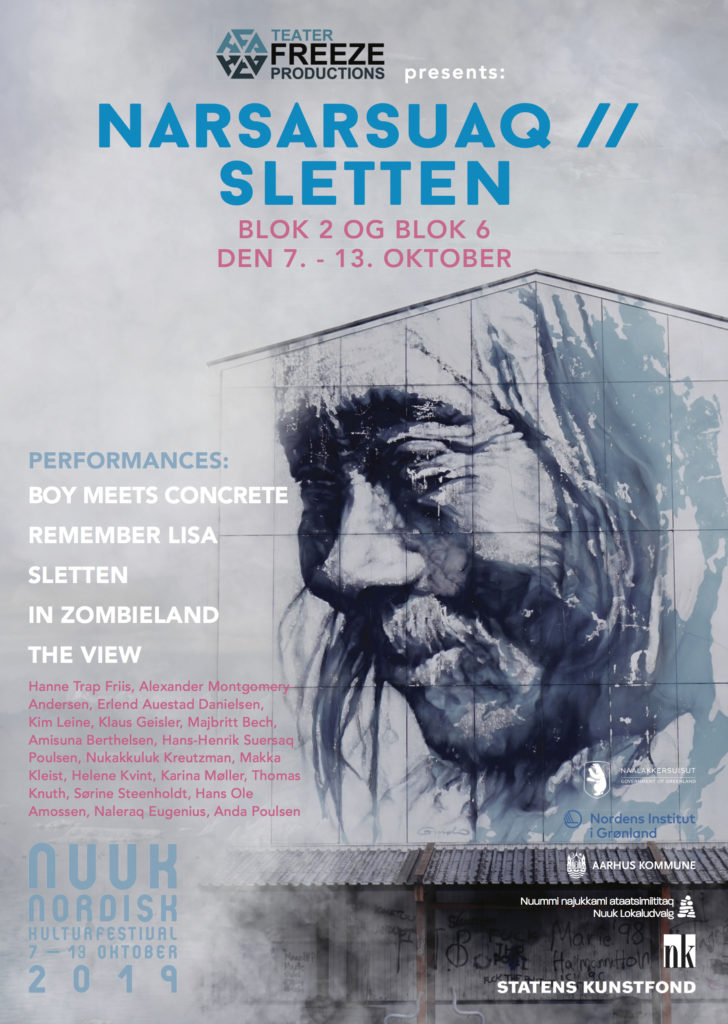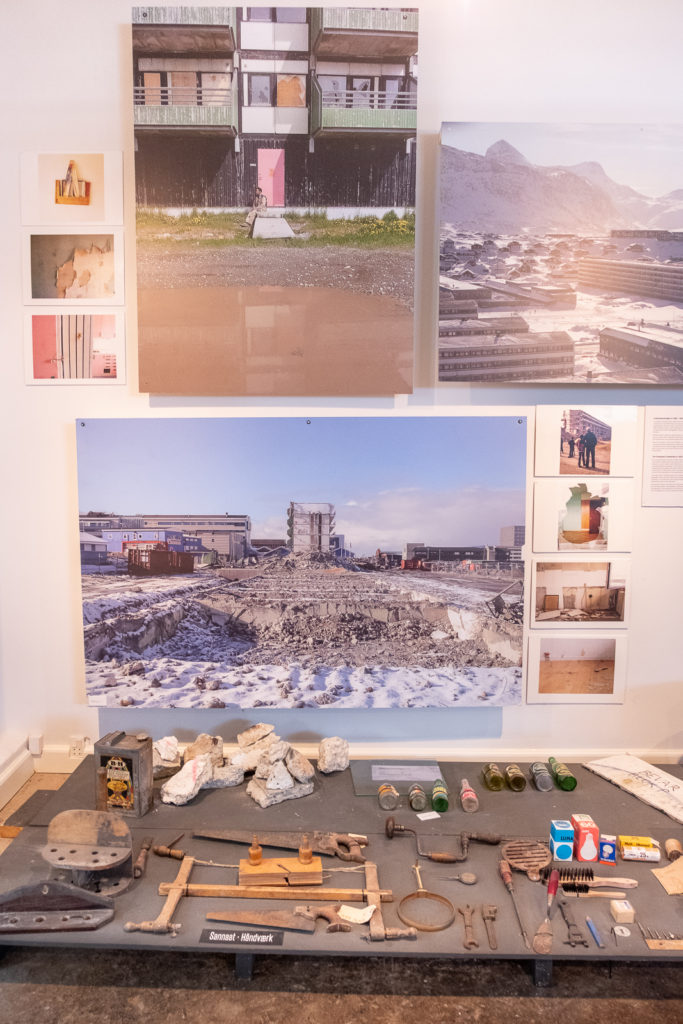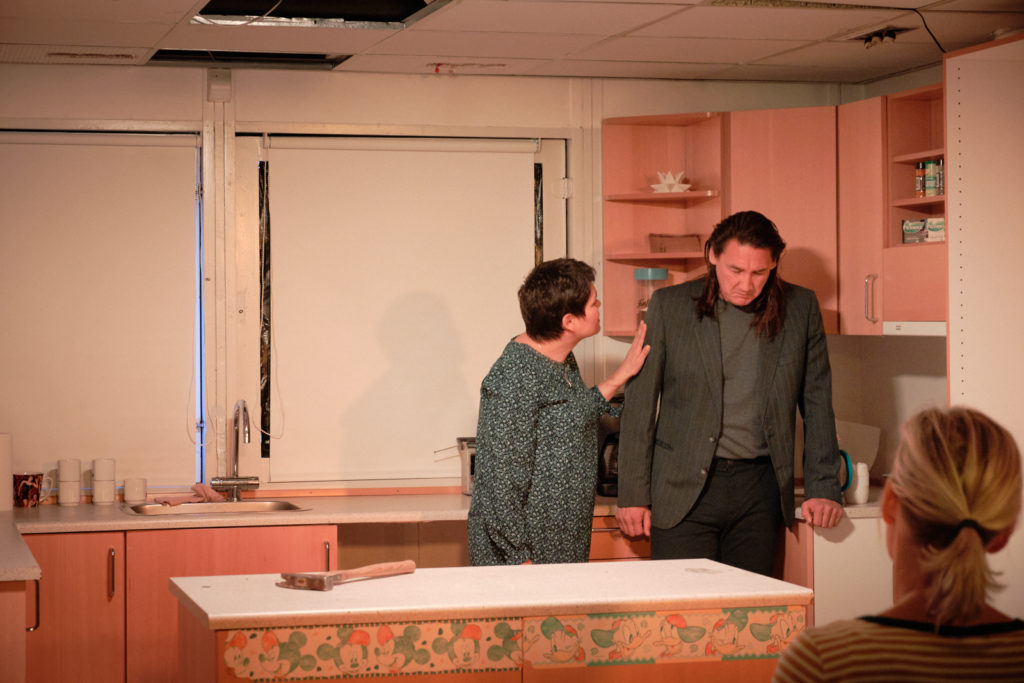Sletten//Narsarsuaq is the most powerful piece of theatre I have ever seen. The highlight of the Nuuk Nordic Culture Festival in 2019 for me, I am still deeply affected by these stories and the remarkable performances I experienced.
The Nuuk Nordic Culture Festival (also known as Nuuk Nordisk) is a biannual week-long festival that brings together artists from throughout Nordic countries. As soon as the early-bird tickets were released back in April, I bought mine – allowing me unlimited access to almost everything that would happen during the festival week.
I had no idea what to expect. But when the program came out several months later, my eyes were immediately drawn to a series of performances that would be held in the “Blocks” – old, run-down apartment buildings that still occupy prime real-estate in central Nuuk.

Nuuk’s Apartment Blocks
I have a strange fascination with the Blocks. Particularly Block P, which was the largest and has become the most famous of them. It was demolished in 2012, 5 years before I visited Greenland for the first time. But that has not stopped me from seeking out information and pouring over the display about it in Nuutoqaq – the Nuuk Local Museum, which features photographs and other items rescued during the demolition. I even found and bought a book about Block P in the Nuuk Art Museum during the week of the festival!

The Blocks were built in the 1960s/70s as part of the Danish Government’s G60 program to urbanize Greenland and move people from the small settlements into larger towns and cities. The aim was to give the Greenlanders the same standard of living as that which existed in Denmark – an admirable aim to be sure. However, having to transition from an Inuit hunter to an apartment-dwelling city worker essentially overnight was too much for many of the displaced locals, and the social ramifications are still felt throughout Greenland.

Narsarsuaq//Sletten
This is exactly what the Narsarsuaq//Sletten multi-performance theatre was about. The description of this large production was essentially as follows:
Narsarsuaq//Sletten. The Blocks 1-10. This area tells the newer story of Nuuk, and of Greenland.
In the 70’s the urbanization of Greenland took place and many small settlements were forced to close. Fishermen and hunters came with their families from beautiful areas along the coast, and were suddenly put into small apartments. What happened? How was it. How is it?
Some were happy (they had all the modern conveniences) and were able to build good strong families. Others lost themselves and their identities.
The Narsarsuaq//Sletten today is full of memories and stories – beautiful, hard, fulfilled, unfulfilled, warm and devastating stories. Stories of the lives that have been lived over the past 30 years and continue to be lived.
Nuuk Nordisk Program 2019

The 5 performances making up this epic show each touched on different aspects of this urbanization project. A production by Teater FreezeProductions, directed by Hanne Trap Friis and featuring some of Greenland’s best actors, dancers, writers and storytellers, I couldn’t wait until they played in English during the last 3 days of the festival (they were in Greenlandic during the first 3 days).
“The View”
“Out this window I have a view of one of the Blocks. Out my other window, I have a view of another of the Blocks. Where I used to live, my views went on forever…”
The View
So begins the monologue of an old Greenlandic lady sitting at her kitchen table in her apartment in Block 2. Makka Kleist delivered an extraordinary solo performance, drawing us in with her storytelling as she reminisced about her life in the settlement with her beloved Kali. At intervals, these happy memories were interrupted by noises from neighbouring apartments, and both she and the audience would abruptly return to the new reality. That of city life in a small apartment.
The way she tells it, there certainly were advantages to moving into the Blocks (it was warm, there was running water, everything worked at the press of a button), but it is clear that her heart still longed to be out in the fjord living the harder life.
“Sletten”
This was the most powerful piece of theatre I have ever seen! Kudos to Kim Leine who wrote it, and Helene Kvint, Karina Møller and Thomas Knuth who performed it.
The story is about a Danish nurse and his wife who come to Greenland for a 2-year stint in the hospital in Nuuk. It is a no-hold-barred look at the relationship between Greenland and Denmark that is played out in the interpersonal relationships of this couple and a Greenlandic woman who has an affair with the husband.

What made it so powerful were the subjects that it broached and the way in which it broached them – head on, in your face, with no holds barred. But also, the fact that it was performed in such a small space. The audience was sat along the two long walls of what I imagine was the living room/kitchen in one of the apartments. The room was about 6m wide and perhaps 15m long (probably an over-estimation), and most of the action took place in the middle of the room. The actors were so close to the audience that you couldn’t help but feel as if you were in the middle of what was going on. And the fact that the actors actually acknowledged the audience as part of the play when they entered the room for the first time, cemented the fact that we were all in this together.

I have never been so affected by a performance in my entire life!
And I have no connection with the history between Greenland and Denmark. I cannot imagine what it must have felt like as a Dane or Greenlander to have your relationship portrayed in such a raw manner. Certainly, there were many eyes that glistened with tears (my own included) by the end of the performance, and the standing ovation the actors received could only begin to express how much we had been all been affected.
In Zombieland
This was another powerful experience based on stories from the collection of novels written by Sørine Steenholdt. Through poetry, dance and music, three young people explored the dreams, fears and hopes of Greenland’s youth while raising to the fore many of the social issues that affect them. Amazing performances by all three actors (Amisuna Berthelsen, Hans-Henrik Suersaq Poulsen and Nukakkuluk Kreutzman), touching on suicide (Greenland has the highest suicide rate in the world), drunkenness and child abuse. No photographs were allowed during this performance.
Boy meets Concrete
I have to admit, I’m a very literal person and not really into interpretive dance. However, I did go to see this performance which apparently explored how “the soft human soul and flesh meet the challenge of the concrete, of the city”. No photographs were allowed during this performance.
Remembering Lisa
The final performance in the series told the story of “Lisa” – a Greenlandic woman who was murdered in Block 6 back in 1985. How many of the current residents of Nuuk remember that this happened? The answer: not many.
And this was the point of the performance. Showing how we should never forget people’s lives, no matter how “ordinary” they may have been.

The story was told through a re-enactment of what may have taken place on that fateful day. Amidst the certainty of the football game happening at the stadium, the fact that kids would have been playing outside between the blocks, and the knowledge of the weather on the day and who the Prime Minister of Greenland was at the time, it is still unknown who killed Lisa. Possible scenarios for the 3 suspects were played out, with two of them rooted once again in the social issues that are still found in Greenland.
A light-hearted moment arises about two-thirds of the way through when Lisa decides that she wants to change the outcome of the story and not end up dead. She forces a re-work of each of the scenarios, interacting with each of the potential suspects in a more generous manner to see if that could make a difference. In two of the scenarios – the outcome was different. But the third…

Final thoughts on Narsarsuaq//Sletten
I have no idea whether this amazing epic will ever be shown elsewhere or ever again. I am so thankful I was able to experience it.
Staging it in the Blocks themselves was absolutely inspired, and I heard the director discuss this as a conscious (and necessary) choice at an Artist Talk during the Nuuk Nordic Culture Festival. The performances would still be amazing in another venue, but to be couped up in the heart of where these stories took place was particularly powerful.
I cannot thank Teater FreezeProductions and all the people involved enough for such an incredible experience. The absolute highlight of Nuuk Nordisk for me.
Recommendation
If you are interested in experiencing a wide range of Nordic culture and art, you should time your visit to Greenland to coincide with the bi-annual Nuuk Nordic Culture Festival. Read more about the festival itself in this article about Nuuk Nordisk, and discover more of what there is to see and do in Greenland’s capital city in the Ultimate Guide to Nuuk.
Discover more about Greenland
The Ultimate Travel Guide to Nuuk provides a complete list of festivals that take place throughout the year in Greenland’s capital. It also has loads of practical information on how to get to Nuuk, how to get around, where to stay, where to eat, and what to do once you arrive.
You can read more about my experiences in Greenland both here and on my Greenland-specific blog at Guide to Greenland.
For more information about Greenland, the best websites are Guide to Greenland (which is also a one-stop-shop for many of the tours available), and Visit Greenland, the Government tourism site.
